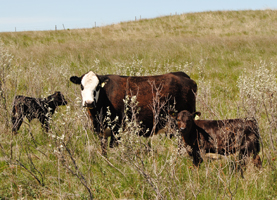This Will Make Your Skin Crawl
This article written by Dr. Reynold Bergen, BCRC Science Director, originally appeared in the April 2018 issue of Canadian Cattlemen magazine and is reprinted on the BCRC Blog with permission of the publisher.

Cattle won’t be the only creatures enjoying fresh pasture this spring; so will the Rocky Mountain wood tick and the American dog tick, which can transmit anaplasmosis and other bloodborne diseases. Anaplasmosis was removed from the Federally Reportable Disease list in 2014, so the government is no longer responsible for dealing with anaplasmosis outbreaks or compensating producers with affected herds. Understanding where these ticks are and what influences their population will help develop proactive strategies to avoid the spread of tickborne disease.
Ticks have a three-stage life cycle. Tick larvae emerge from the egg and feed once on blood from small mammals (mice, voles, squirrels, etc.). The engorged larvae then molt into nymphs that also feed once on small mammals. The engorged nymphs molt into adults that feed on larger animals, including dogs, sheep, deer, and cattle. If the adult ticks cannot find a host, they may overwinter under plant material on the ground and re-emerge in spring. Adult ticks begin looking for hosts after the snow melts, which can be from March to May, depending on the region. Wood tick activity generally peaks in May, while dog tick activity peaks in May or June, and fades in late June through July. Once a suitable host is found, the adult ticks feed and mate on the animal. The engorged females drop to the ground, lay several thousand eggs a few weeks later, die, and the cycle continues. This life cycle can be completed in one year but usually takes two to three years.
Infected cattle are sources of infection for others in the herd. Male ticks may move from one host animal to another seeking mates. Any tick that picks up the anaplasmosis bacterium from an infected host, can transmit the pathogen when it feeds on uninfected cattle.
Surveys from a half century ago found that the Rocky Mountain wood tick occurred in B.C., Alberta, and western Saskatchewan, and the American dog tick occurred east of central Saskatchewan. An 80km gap in south-central Saskatchewan separated the two species. Their ranges may have expanded or contracted since then due to movement on animals, changing farming practices, grassland acreage, or climate.
Shaun Dergousoff and Tim Lysyk (AAFC Lethbridge) and collaborators at the Universities of Saskatchewan (Neil Chilton) and Manitoba (Kateryn Rochon) carried out a study funded by the Beef Science Cluster to update these tick distribution maps.
What They Did:
Over 200 sites from Western BC to the Manitoba-Ontario border were sampled for ticks in April through July in 2014, 2015 and 2016. Environmental conditions, such as vegetation, soil, temperature, and precipitation were recorded for each location.
What they Learned:
The Rocky Mountain wood tick hasn’t moved very far over the past half century. It was found in all three years in 20% of the BC sites, 32% of the Alberta sites and 17% of the Saskatchewan sites. It was never found in Manitoba. Tick density was slightly higher in Alberta than in BC or Saskatchewan and was fairly consistent from year to year. It wasn’t found north of a line drawn through Dundurn, SK and Didsbury, AB, and wasn’t found east of Foam Lake, SK. It was most likely to occur where average fall and winter temperatures were between -2 and -5oC, and where springs were moist and summers were dry.
The American dog tick has expanded its range by at least 350 km to the north and 300 km to the west since the 1960’s. It was found all three years in 81% of the Manitoba and 70% of the Saskatchewan sites. Tick density was similar between Saskatchewan and Manitoba in all years. It was rarely found west of Lloydminster, occurring at only a few locations in Alberta and BC in 2016 and wasn’t found north of Nipawin, SK. It was most common where fall and winter temperatures averaged -6 to -10oC, and where spring precipitation levels were between 155 to 164 mm.
What it Means:
The Rocky Mountain wood tick and American dog tick aren’t geographically isolated anymore. Their ranges overlap by more than 300 km in southern Saskatchewan. These ticks share the same hosts throughout their lifecycles, so the fact that their ranges overlap may increase the risk that bloodborne diseases may spread further or faster than they could have before.
Understanding the geographic range and the environmental conditions that ticks prefer helps to assess the risk of tick infestations in a particular year or region, and helps producers decide whether altered grazing management practices or the use of a permethrin or pyrethrin product for parasite control is something to discuss with your veterinarian.
The fires across Western Canada last summer and fall may pose a temporary setback to some tick infested areas, but as soon as there is enough vegetation to attract wild animals, the ticks will move back in with their hosts.
Click here to subscribe to the BCRC Blog and receive email notifications when new content is posted.
The sharing or reprinting of BCRC Blog articles is typically welcome and encouraged, however this article requires permission of the original publisher.
We welcome your questions, comments and suggestions. Contact us directly or generate public discussion by posting your thoughts below.